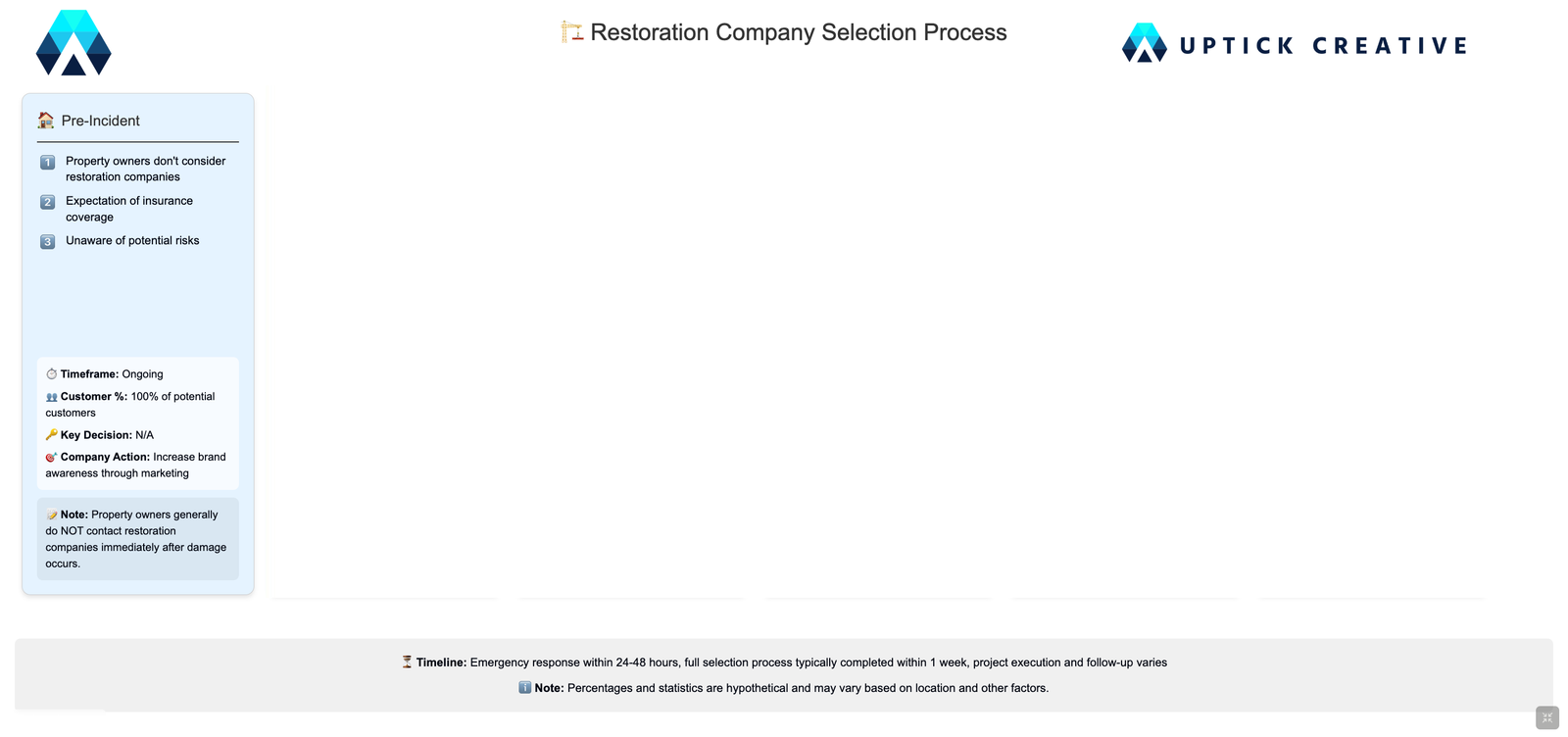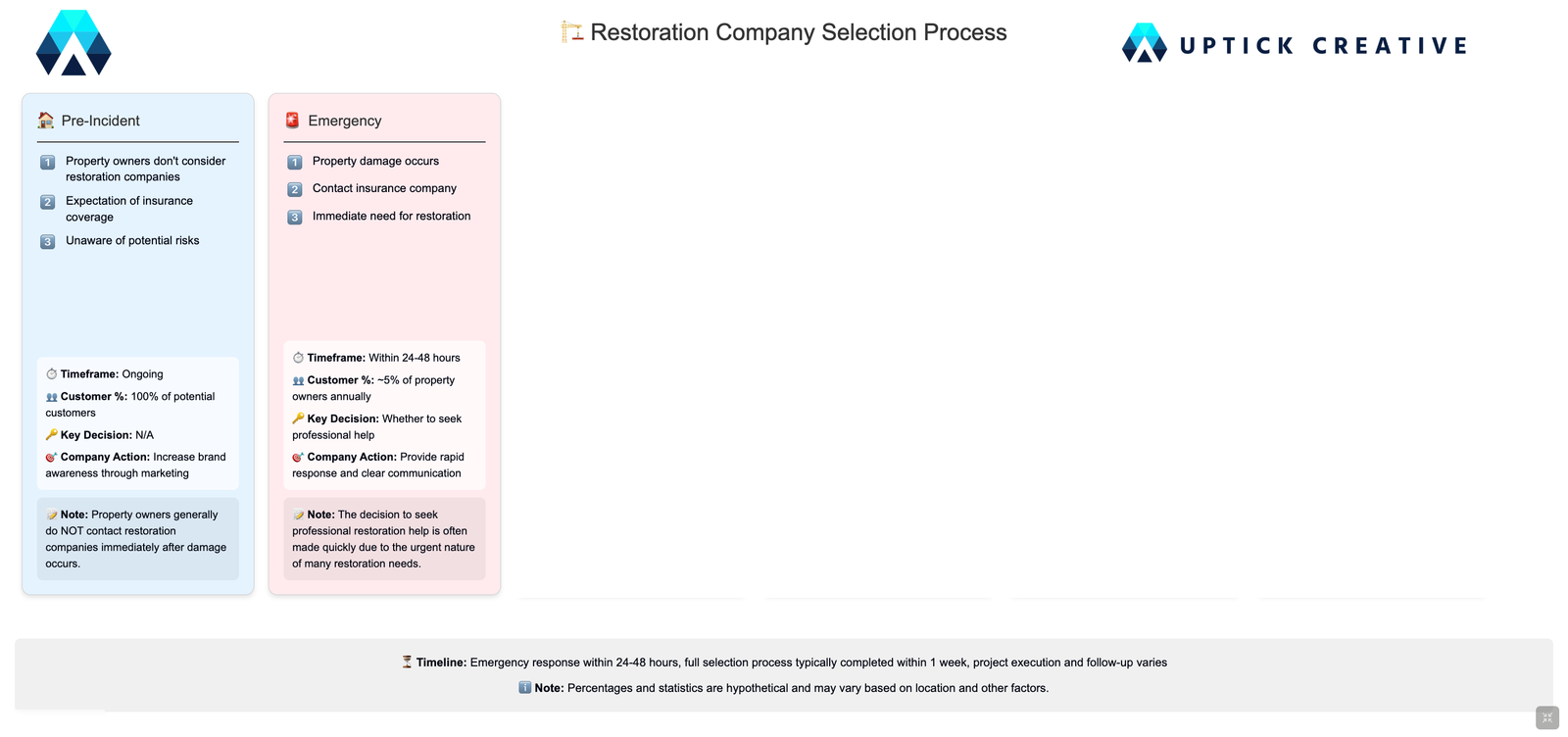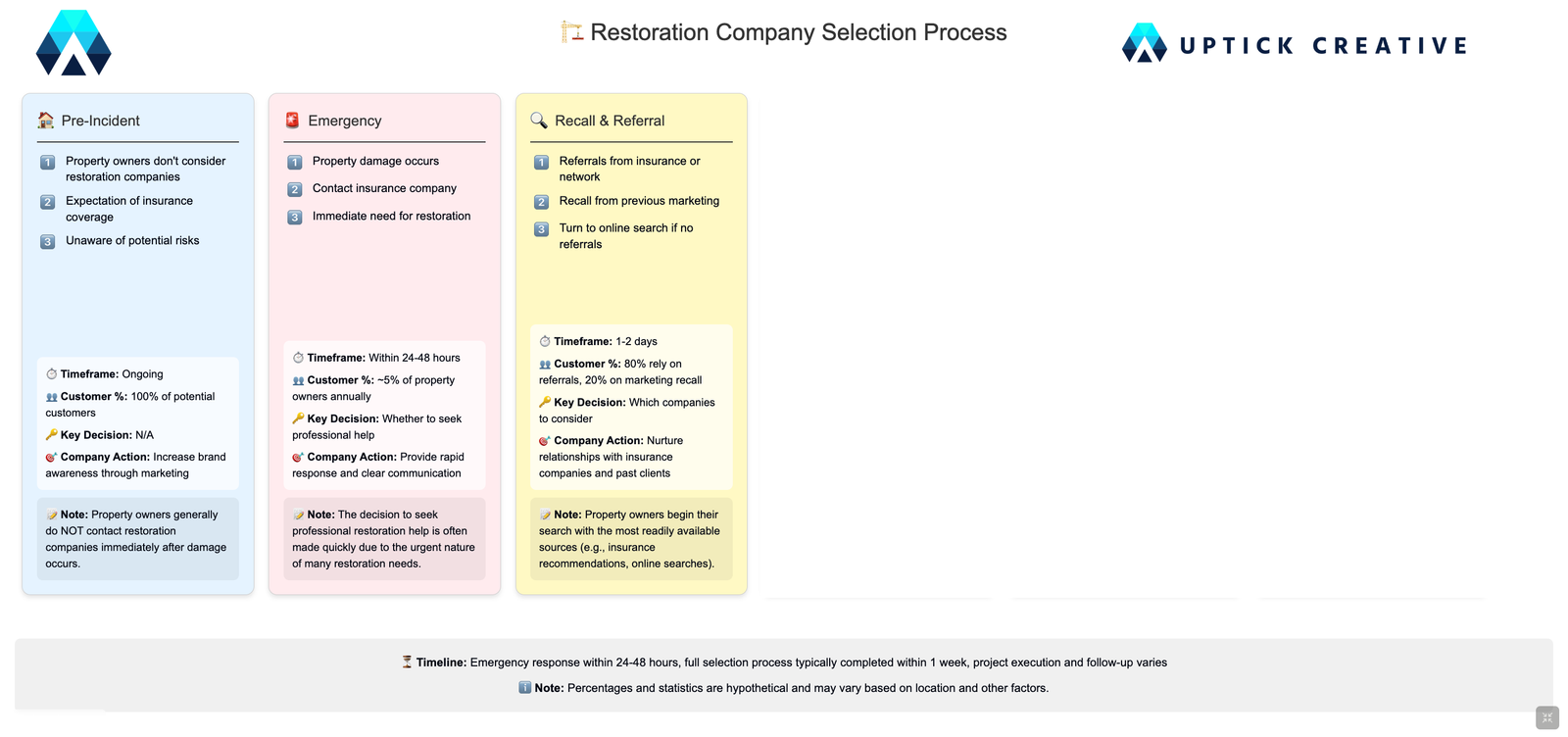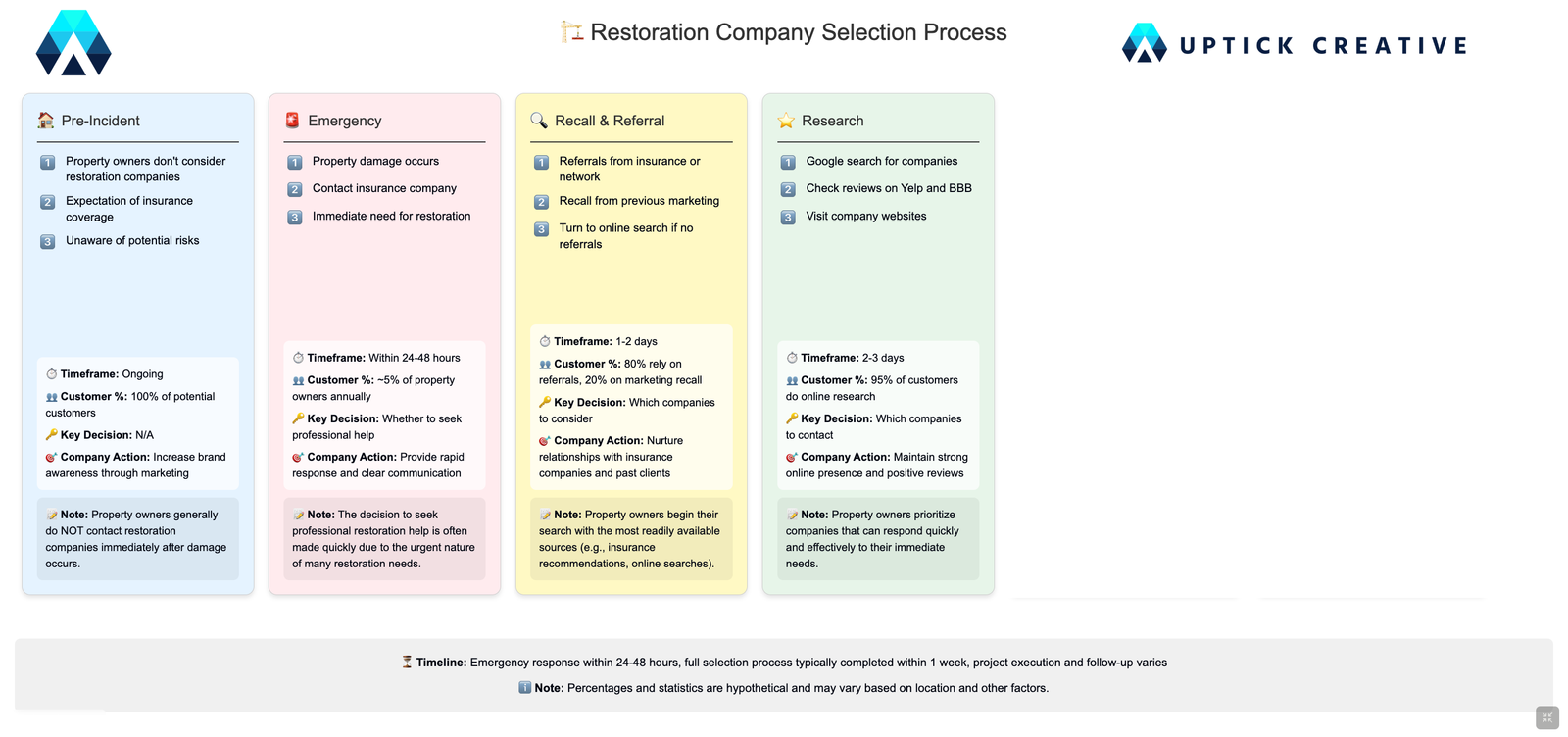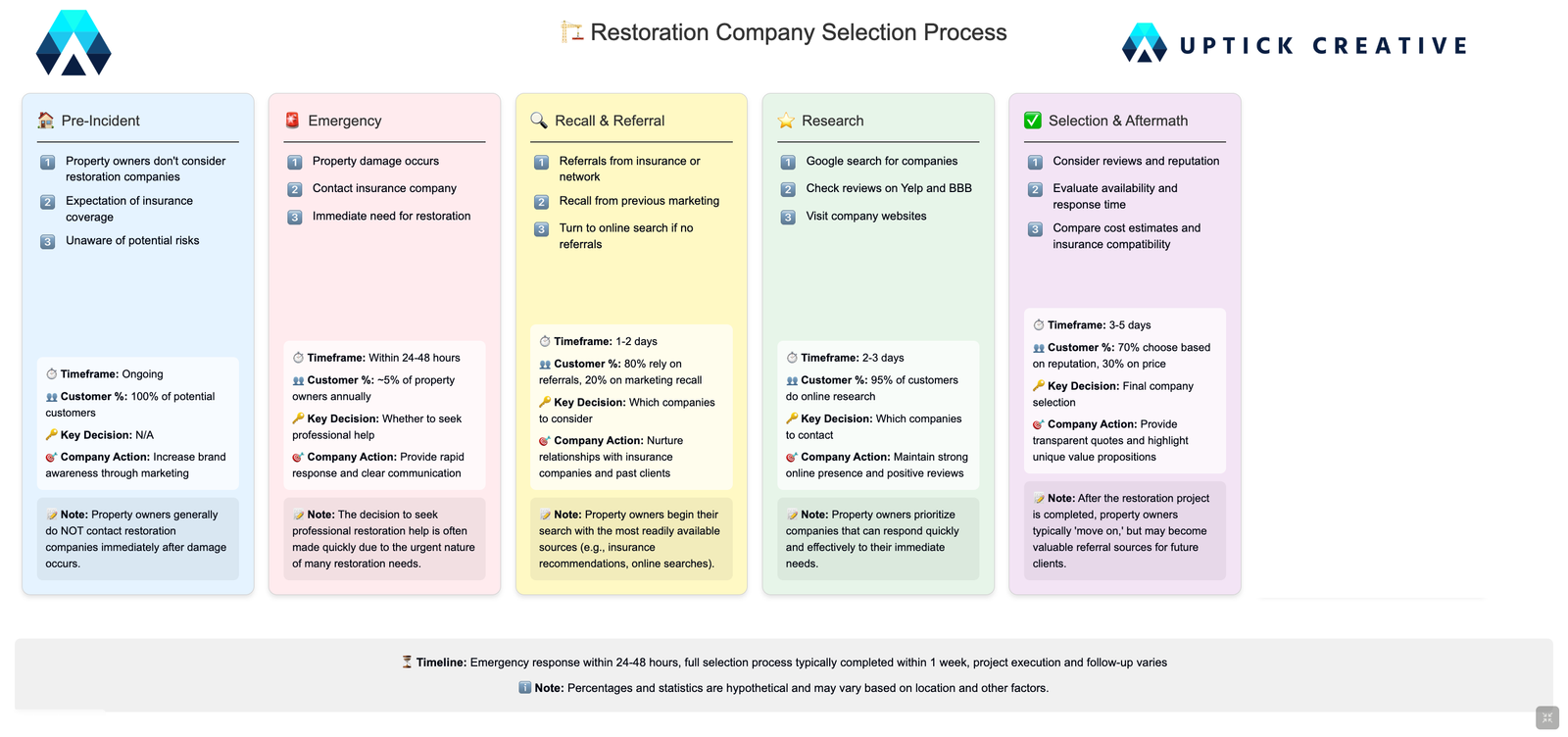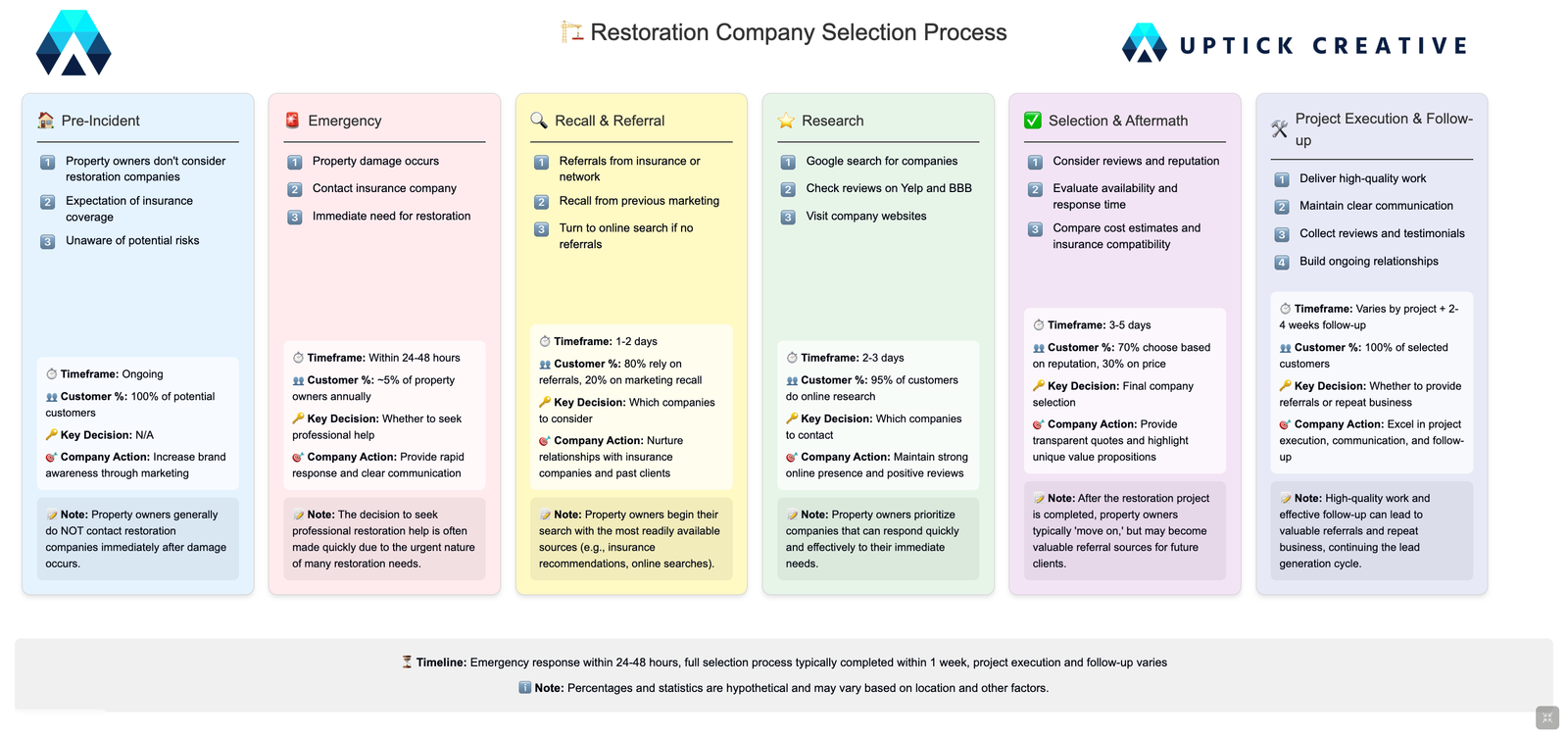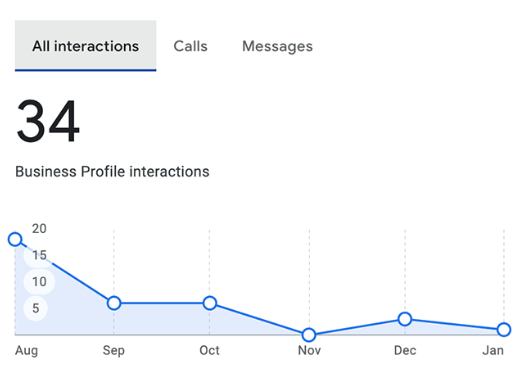As a restoration company owner, you’re acutely aware of the unique challenges in generating leads for your business. Unlike many industries where customers can plan their purchases, your potential clients often need your services unexpectedly and urgently. This reality demands a Restoration Lead Generation Process that is proactive, comprehensive, and always-on.
So, how do you effectively implement a Restoration Lead Generation Process that reaches those who need your help the most, often before they even know they need you?
The answer lies in understanding the intricate journey your potential clients take – from the moment before disaster strikes to the time they decide to hire a restoration company. This journey forms the backbone of an effective Restoration Lead Generation Process.
At Uptick Creative, we’ve been helping restoration companies refine their Restoration Lead Generation Process for years. Through our work, we’ve collected extensive data on how people search for, evaluate, and ultimately select restoration services. This data has allowed us to develop a comprehensive understanding of the Restoration Lead Generation Process that drives results.
In this guide, we’ll break down the Restoration Company Lead Generation Process into six crucial stages, providing you with actionable insights to optimize each step. By mastering this process, you’ll be able to generate a steady stream of high-quality leads, even in the unpredictable world of restoration services.
In this comprehensive guide, I’m going to share those insights with you.
By the end of this article, you will….
- Have a clear understanding of the six-stage process potential clients go through when seeking restoration services
- Know how to leverage this knowledge to dramatically reduce your marketing expenses while increasing your lead generation performance.
- Be equipped with actionable strategies and tactics for each stage of the process
Let’s dive into the details of each stage and explore how you can optimize your lead generation efforts.
Table of Contents
ToggleStage #1: Pre-Incident Awareness
The journey begins before any incident occurs. While most people don’t actively think about restoration services until they need them, building brand awareness during this stage is crucial.
Why Pre-Incident Awareness Matters
- It increases the likelihood of recall when an emergency does occur
- It builds trust and credibility over time
- It positions your company as an industry expert
Strategies for Building Pre-Incident Awareness
- Consistent, Targeted Marketing
- Develop a cohesive brand identity across all marketing channels
- Use targeted online ads to reach your ideal customer demographics
- Invest in local sponsorships and community events
- Relationship Building
- Establish partnerships with insurance companies
- Offer educational seminars for insurance agents
- Provide co-branded materials on disaster preparedness
- Network with property managers and real estate professionals
- Attend industry events and trade shows
- Offer free property assessments or disaster planning consultations
- Establish partnerships with insurance companies
- Educational Content Creation
- Develop a content calendar focusing on prevention and preparedness topics
- Create blog posts, videos, and infographics on topics like:
- “10 Steps to Prevent Water Damage in Your Home”
- “How to Create a Fire Escape Plan for Your Business”
- “The Ultimate Guide to Storm Preparedness”
- Share this content across your website, social media, and email newsletters
Example: Pre-Incident Awareness Campaign
Let’s say you’re running a water damage restoration company in Miami. Here’s an example of a pre-incident awareness campaign:
- Create a hurricane preparedness guide
- Promote the guide through targeted Facebook ads to homeowners in Miami
- Offer free in-person workshops on hurricane preparedness at local community centers
- Partner with local insurance agents to distribute the guide to their clients
- Share tips from the guide in a series of social media posts leading up to hurricane season
By implementing these strategies, you’re positioning your company as a trusted expert, making it more likely that potential clients will think of you when they need restoration services.
Stage #2: The Emergency Response
When disaster strikes, potential clients need help fast. Your ability to respond quickly and effectively can make or break your chances of winning their business.
Key Factors in Emergency Response
- 24/7 Availability
- Set up a dedicated emergency hotline
- Implement an on-call system for your team
- Use a professional answering service for after-hours calls
- Clear, Empathetic Communication
- Train your staff in crisis communication
- Develop scripts for common emergency scenarios
- Use empathetic language and active listening techniques
- Rapid Response Times
- Aim to respond to all inquiries within 15-30 minutes
- Use GPS tracking to dispatch the nearest available team
- Implement a streamlined dispatch process
Our data shows that companies who respond within 30 minutes of initial contact are 21% more likely to win the job.
Steps to Improve Your Emergency Response
- Conduct an audit of your current response times and processes
- Identify bottlenecks and areas for improvement
- Invest in technology to streamline your response (e.g., automated dispatching software)
- Develop a comprehensive training program for all customer-facing staff
- Regularly drill your team on emergency scenarios
- Collect and analyze data on response times and conversion rates
- Continuously refine and improve your processes based on this data
Example: Emergency Response Protocol
Here’s an example of how your emergency response protocol might look:
- Call received by 24/7 answering service
- Call details immediately sent to on-call supervisor via mobile app
- Supervisor assesses situation and dispatches nearest available team
- Team arrives on-site within 60 minutes of initial call
- On-site team provides immediate assessment and begins mitigation work
- Follow-up call made to client within 24 hours to ensure satisfaction
By implementing a robust emergency response system, you’ll not only win more jobs but also build a reputation for reliability and professionalism.
Stage #3: The Recall and Referral Process
When faced with property damage, people often turn to two sources for help:
- Their memory (recall)
- Recommendations from trusted sources (referrals)
Strategies for Enhancing Recall
- Consistent Branding
- Use a memorable logo and color scheme across all marketing materials
- Develop a catchy slogan or jingle
- Maintain consistent messaging across all platforms
- Strategic Advertising
- Invest in targeted local advertising (billboards, radio, TV)
- Use retargeting ads to stay top-of-mind after website visits
- Sponsor local events and sports teams for increased visibility
- Community Involvement
- Participate in local charity events
- Offer free educational workshops for homeowners and businesses
- Sponsor local youth sports teams or community programs
Building a Strong Referral Network
- Insurance Company Partnerships
- Develop relationships with local insurance agents
- Offer co-branded educational materials
- Provide excellent service to their clients to build trust
- Customer Referral Program
- Implement a structured referral program with clear incentives
- Make it easy for satisfied customers to refer others
- Follow up with referrers to show appreciation
- Professional Network
- Join local business associations and networking groups
- Develop partnerships with complementary businesses (e.g., plumbers, electricians)
- Offer reciprocal referral arrangements
Step-by-Step Guide to Launching a Referral Program
- Define your incentives (e.g., discount on future services, cash reward)
- Create marketing materials explaining the program
- Train your team to ask for referrals at appropriate times
- Implement a system to track referrals and rewards
- Promote the program through email, social media, and in-person interactions
- Follow up with both the referrer and the new client to ensure satisfaction
- Analyze program performance and adjust as needed
Example: Multi-Channel Recall Campaign
Here’s an example of how you might implement a multi-channel recall campaign:
- Develop a memorable slogan: “When Water Strikes, We Make It Right!”
- Create a series of local TV ads showcasing your quick response and quality work
- Sponsor a local youth soccer team, with your logo on their jerseys
- Implement a Google Ads campaign targeting local searchers
- Distribute branded refrigerator magnets with emergency contact info to past clients
- Host a booth at a local home and garden show, offering free water damage prevention tips
By focusing on both recall and referrals, you’ll create multiple pathways for potential clients to find and choose your services.
Stage #4: The Research Process
In today’s digital age, even in emergencies, people often turn to the internet to research their options. This is where your online presence becomes crucial.
Optimizing Your Online Presence
- Website Optimization
- Ensure your website is mobile-responsive and fast-loading
- Create clear, informative service pages
- Implement a user-friendly contact form and prominent phone number
- Use high-quality images and videos of your work
- Search Engine Optimization (SEO)
- Conduct keyword research for restoration-related terms
- Optimize your website’s on-page SEO (title tags, meta descriptions, headers)
- Create location-specific landing pages for each service area
- Build high-quality backlinks from local and industry-relevant websites
- Online Directories and Citations
- Claim and optimize your Google Business Profile
- Ensure consistent Name, Address, and Phone (NAP) information across all online directories
- List your business on industry-specific directories (e.g., IICRC, Restoration Industry Association)
Managing Your Online Reputation
- Review Generation
- Implement a systematic approach to requesting reviews from satisfied clients
- Make it easy for clients to leave reviews by providing direct links
- Respond promptly and professionally to all reviews, both positive and negative
- Testimonials and Case Studies
- Collect detailed testimonials from clients, including before and after photos
- Create case studies showcasing complex restoration projects you’ve completed
- Share these testimonials and case studies on your website and social media
- Social Proof
- Display awards, certifications, and industry affiliations prominently on your website
- Use trust badges (e.g., BBB accreditation, Google Guaranteed) to build credibility
- Showcase real-time review scores on your website
Creating Informative Content
- Blog Posts
- Develop a content calendar covering various restoration topics
- Write in-depth, informative articles addressing common questions and concerns
- Use a mix of text, images, and videos to engage readers
- Video Content
- Create how-to videos on topics like “What to Do Immediately After Water Damage”
- Produce behind-the-scenes videos showcasing your team and equipment
- Use video testimonials from satisfied clients
- Infographics and Visual Content
- Design infographics on topics like “The Water Damage Restoration Process”
- Create before-and-after image galleries of your restoration projects
- Develop shareable content for social media platforms
Step-by-Step Guide to Local SEO for Restoration Companies
- Conduct keyword research using tools like Google Keyword Planner or SEMRush
- Optimize your website’s on-page SEO for target keywords
- Create location-specific service pages (e.g., “Water Damage Restoration in [City Name]”)
- Claim and optimize your Google Business Profile
- Build citations on relevant local directories
- Encourage and respond to customer reviews
- Create locally-focused content (e.g., “Preparing for [Local Weather Event]”)
- Build relationships with other local businesses for potential backlinks
- Monitor your local search rankings and adjust strategy as needed
By dominating the research process, you’ll ensure that potential clients find and choose your company when they’re actively seeking restoration services.
Stage #5: The Selection Process
Once potential clients have done their research, they enter the selection phase. This is where they decide which restoration company to hire.
Providing Transparent and Competitive Quotes
- Clear Pricing Structure
- Develop a straightforward pricing model
- Explain the factors that influence cost (e.g., extent of damage, materials needed)
- Offer itemized quotes for transparency
- Competitive Analysis
- Regularly research competitor pricing
- Identify areas where you can offer better value
- Consider offering price matching or guarantees
- Value-Added Services
- Include complementary services in your quotes (e.g., free mold inspection)
- Offer financing options for larger projects
- Provide warranty or guarantee on your work
Highlighting Unique Value Propositions
- Identify Your Unique Selling Points (USPs)
- Faster response times
- Advanced restoration techniques or equipment
- Specialized expertise (e.g., historical building restoration)
- Communicate Your USPs
- Feature USPs prominently on your website and marketing materials
- Train your team to articulate these points during client interactions
- Use case studies to demonstrate the real-world impact of your USPs
- Customer-Centric Approach
- Offer 24/7 project tracking for clients
- Provide a dedicated project manager for each job
- Implement a satisfaction guarantee
Demonstrating Expertise and Trustworthiness
- Showcase Certifications and Training
- Highlight industry certifications (e.g., IICRC) on your website and marketing materials
- Regularly update and expand your team’s certifications
- Share details about your ongoing training programs
- Leverage Social Proof
- Display customer testimonials prominently
- Showcase awards and recognition from industry organizations
- Use data and statistics to back up your claims (e.g., “95% of jobs completed within 72 hours”)
- Educate Your Potential Clients
- Provide detailed explanations of your restoration processes
- Offer free resources (e.g., disaster preparedness guides)
- Host webinars or in-person workshops on relevant topics
Example: Unique Value Proposition Statement
“At [Your Company Name], we combine rapid 30-minute response times with cutting-edge restoration technology to minimize damage and get you back to normal faster. Our IICRC-certified technicians are available 24/7, and we offer a 100% satisfaction guarantee on all our work.”
By focusing on transparency, unique value, and demonstrated expertise during the selection process, you’ll increase your chances of being chosen by potential clients.
Stage #6: Project Execution and Follow-up
The lead generation process doesn’t end when you win the job. How you execute the project and follow up afterward can lead to valuable referrals and repeat business.
Delivering High-Quality Work
- Standardized Processes
- Develop and document standard operating procedures for each type of restoration job
- Implement quality control checks at key stages of each project
- Regularly review and update processes based on new industry standards and technologies
- Team Training and Development
- Provide ongoing training for all team members
- Encourage and support additional certifications
- Foster a culture of continuous improvement
- Use of Advanced Technology
- Invest in state-of-the-art restoration equipment
- Implement project management software for efficient job tracking
- Use moisture mapping technology for accurate assessment and documentation
Maintaining Clear Communication Throughout the Project
- Regular Updates
- Establish a communication schedule with clients (e.g., daily updates)
- Use a mix of communication channels (phone, email, text) based on client preference
- Provide visual updates (photos, videos) of project progress
- Transparent Project Management
- Use project management software that allows client access
- Clearly explain each stage of the restoration process
- Promptly communicate any changes or unexpected issues
- Responsive Customer Service
- Assign a dedicated point of contact for each client
- Implement a system for quick response to client queries
- Train all team members in effective customer communication
Post-Project Follow-up and Review Collection
- Systematic Follow-up Process
- Conduct a final walkthrough with the client
- Send a post-project survey within 24-48 hours
- Schedule a follow-up call 1-2 weeks after project completion
- Review Collection
- Ask satisfied clients for reviews on key platforms (Google, Yelp, etc.)
- Provide easy links or instructions for leaving reviews
- Consider offering small incentives for leaving honest reviews (ensure compliance with platform policies)
- Ongoing Relationship Building
- Add clients to your email newsletter list (with permission)
- Send periodic check-ins or maintenance reminders
- Offer loyalty discounts for repeat business or referrals
Step-by-Step Guide to Collecting and Leveraging Testimonials
- Identify your most satisfied customers
- Request detailed feedback about their experience
- Ask permission to use their comments as a testimonial
- Collect specific details about the project and results
- Take high-quality before and after photos (with permission)
- Draft the testimonial based on the client’s feedback
- Get approval from the client on the final version
- Create various formats of the testimonial (text, video, social media snippets)
- Share the testimonial across your marketing channels
- Follow up with the client to show appreciation and maintain the relationship
By excelling in project execution and follow-up, you not only ensure client satisfaction but also set the stage for future leads through referrals and repeat business.
Putting It All Together: Integrating the Six Stages into Your Marketing Strategy
Now that you understand the six stages of the restoration company lead generation process, it’s time to integrate this knowledge into a comprehensive marketing strategy. This holistic approach will ensure that you’re effectively capturing and nurturing leads at every stage of their journey.
1. Develop a Multi-Channel Marketing Plan
Create a marketing plan that addresses each stage of the lead generation process:
- Pre-Incident Awareness: Implement brand awareness campaigns across various channels (social media, local advertising, community events)
- Emergency Response: Optimize your website and ads for emergency-related keywords
- Recall and Referral: Develop a strong referral program and maintain consistent branding
- Research: Invest in SEO and content marketing to dominate local search results
- Selection: Highlight your unique value propositions across all marketing materials
- Project Execution and Follow-up: Implement a system for collecting and showcasing client testimonials
2. Align Your Team
Ensure that every member of your team understands their role in the lead generation process:
- Conduct regular training sessions on the six stages
- Develop scripts and guidelines for customer interactions at each stage
- Implement a system for tracking and measuring performance at each stage
3. Leverage Technology
Invest in tools and software that can help streamline your lead generation efforts:
- Customer Relationship Management (CRM) system to track leads through each stage
- Marketing automation software for nurturing leads
- Call tracking software to measure the effectiveness of different marketing channels
4. Continuously Measure and Optimize
Regularly analyze your performance at each stage and make data-driven improvements:
- Set Key Performance Indicators (KPIs) for each stage (e.g., response time, conversion rate)
- Use analytics tools to track website performance and user behavior
- Conduct A/B tests on your marketing messages and tactics
Example: Integrated Marketing Campaign
Here’s an example of how you might integrate the six stages into a cohesive marketing campaign:
- Run a “Disaster Preparedness Month” campaign, offering free home assessments (Pre-Incident Awareness)
- Optimize your Google Ads for emergency keywords like “water damage repair near me” (Emergency Response)
- Implement a referral program, offering discounts to both the referrer and new client (Recall and Referral)
- Create in-depth blog posts about restoration processes, optimized for local SEO (Research)
- Develop case studies highlighting your unique approach and results (Selection)
- Implement an automated follow-up system for post-project feedback and reviews (Project Execution and Follow-up)
Prioritize Reputation Management
Given the importance of trust in the restoration industry, actively managing your online reputation is crucial. A strong reputation can significantly impact your lead generation efforts across all stages of the process.
1. Systematic Review Collection
Develop a process for consistently gathering client feedback:
- Implement an automated system that sends review requests post-project
- Train your team to ask for reviews at the right moment (e.g., during the final walkthrough)
- Offer incentives for leaving reviews (ensure compliance with platform policies)
2. Proactive Review Management
Actively monitor and respond to all reviews:
- Set up alerts for new reviews across all platforms
- Develop response templates for common scenarios (both positive and negative)
- Aim to respond to all reviews within 24 hours
3. Leverage Positive Reviews
Use your best reviews to boost your reputation:
- Feature top reviews prominently on your website and marketing materials
- Create social media content highlighting positive client experiences
- Use review snippets in your Google Ads to improve click-through rates
4. Address Negative Reviews Constructively
Turn negative feedback into an opportunity to showcase your commitment to customer satisfaction:
- Respond publicly with empathy and a solution-oriented approach
- Take the conversation offline to resolve issues
- Follow up publicly once the issue is resolved
5. Showcase Expertise and Certifications
Demonstrate your industry knowledge and qualifications:
- Regularly publish thought leadership content (blog posts, whitepapers, webinars)
- Display industry certifications prominently on your website and marketing materials
- Participate in industry conferences and events, sharing insights on social media
Example: Reputation Management Workflow
- Complete a restoration project
- Send an automated review request email within 24 hours
- If no review is left, follow up with a phone call after 3 days
- For positive reviews, respond with gratitude and share on social media
- For negative reviews, respond publicly with empathy, then reach out privately to resolve the issue
- Once resolved, request an updated review
- Analyze review trends monthly and adjust operations as needed
Invest in Customer Communication and Lead Nurturing
Effective communication can set you apart in an industry where clients are often stressed and uncertain. By implementing robust communication and lead nurturing systems, you can improve conversion rates and customer satisfaction across all stages of the lead generation process.
1. Implement an Efficient Emergency Response System
Optimize your process for handling urgent inquiries:
- Set up a dedicated emergency hotline
- Use an automated system to immediately dispatch the nearest available team
- Implement a callback system to ensure no leads slip through the cracks
2. Develop a Lead Nurturing Strategy
Create a system for staying in touch with leads at different stages:
- Segment your leads based on their needs and stage in the decision process
- Develop targeted email campaigns for each segment (e.g., educational content for early-stage leads, case studies for leads close to deciding)
- Use retargeting ads to stay top-of-mind with leads who have visited your website
3. Leverage Technology for Streamlined Communication
Invest in tools that facilitate clear, consistent communication:
- Implement a project management system that allows clients to track progress in real-time
- Use chatbots on your website to provide instant responses to common queries
- Utilize SMS updates for time-sensitive communication during projects
4. Personalize Your Communication
Tailor your messaging to each client’s unique situation:
- Use your CRM to track client preferences and history
- Develop communication templates that can be easily personalized
- Train your team in empathetic communication techniques
5. Implement a Follow-Up System
Create a structured process for following up with leads and clients:
- Set up automated email sequences for different types of inquiries
- Schedule regular check-ins with past clients to maintain relationships
- Develop a reactivation campaign for dormant leads
Example: Lead Nurturing Workflow
- Receive an initial inquiry through your website
- Immediately send an automated response with helpful information
- Follow up with a personal phone call within 1 hour
- If not ready to proceed, add the lead to a nurturing email sequence
- Send targeted content based on their specific concerns (e.g., water damage, fire restoration)
- Use retargeting ads to showcase your services as they browse the web
- After 2 weeks, follow up with a personalized offer or free consultation
- If they become a client, continue communication through project management system
- After project completion, enter them into a long-term nurturing sequence for future needs
By implementing these comprehensive strategies for reputation management and customer communication, you’ll be well-positioned to generate a steady stream of high-quality leads and turn them into satisfied, loyal clients.
The Bottom Line
Generating a consistent stream of high-quality leads for your restoration company doesn’t have to be a mystery. By understanding the six stages of the client journey and tailoring your marketing efforts accordingly, you can attract more of your ideal clients while reducing your overall marketing expenses.
At Uptick Creative, we specialize in helping restoration companies create comprehensive, data-driven marketing strategies that deliver real results. If you’re ready to take your lead generation to the next level, we’d love to chat.
Book a call with our team today, and let’s discuss how we can put our expertise to work for your company. Together, we can develop a customized plan to help you stand out in a competitive market, connect with more potential clients, and ultimately grow your business.


